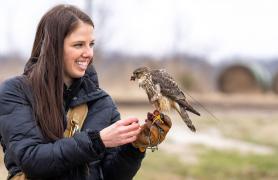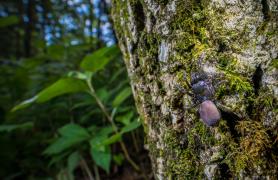There are many creatures to enjoy and admire in Missouri’s outdoors, but feral hogs aren’t one of them.
They harm crop fields and pose disease threats to domestic hogs, pets, and even humans. Their destructive habits have far-reaching effects on wildlife and their habitats. To bottom line it, there’s nothing desirable, valuable, or appealingabout feral hogs. In Missouri, the disdain for these invasive hogs starts at the top.
“Feral hogs are a danger to our state and pose serious safety risks to Missourians,” Governor Mike Parson said. “They threaten both outdoor recreation and Missouri’s agriculture industry — the backbone of our economy.”
Gov. Parson’s words echo the sentiment many biologists, farmers, and outdoor recreationalists across the state have towards feral hogs.
“I hate them,” said Pat Hobbs, a Stoddard County farmer who’s active with the Missouri Soybean Association. “There is no good use for them and they don’t belong in the U.S.”
Stronger Together
Missouri’s current effort to eliminate feral hogs from the state is a multi-agency mission that involves MDC, Missouri Department of Agriculture (MDA), U.S. Forest Service (USFS), USDA Animal and Plant Health Inspection Service (APHIS), and 10 more strong partners that make up the Missouri Feral Hog Elimination Partnership (MFHEP). This group, which is currently chaired by MDC, was formed in 2015 and is the next generation of a task force that was formed by Gov. Matt Blunt in 2007 with a goal to aggressively control feral hogs in Missouri. The partnership’s collaborative efforts have produced significant results, particularly in recent years. In 2020 alone, trappers have killed 7,482 feral hogs in Missouri through July. Since 2017, 33,932 have been killed.
“We are turning the corner in our war on feral hogs,” said Jason Jensen, who is MDC’s incident commander for feral hog operations. “The incident command structure that we have employed has all the players in the partnership on the same team working in a very coordinated way. This helps to ensure accountability while avoiding duplication of effort and resources.”
Besides taking hogs off the landscape, this collaborative effort has also helped keep dollars in billfolds. A USDA Wildlife Services report from earlier this year showed that MFHEP’s feral hog management efforts, in the period from 2016–2019, prevented a minimum of $24.9 million of annual damage to agricultural production.
“As this was a generalized analysis, it is believed this number may be an under estimation of the actual damages prevented, especially since it does not include damage to natural resources,” said Travis Guerrant, the state director for the Missouri/ Iowa APHIS Wildlife Services Program. Guerrant stressed the damage feral hogs could do to Missouri’s ag economy if they got established in the Show-Me State is something that cannot be taken lightly. He points to a Texas A&M University study that estimates that feral hogs cause $52 million of agricultural damage in Texas each year. On a broader scale, the USDA estimates feral hogs cause approximately $1.5 billion in damage and control costs in the U.S. each year — $800 million of that is due to direct damage to agriculture.
“In Missouri, feral hogs exist in the southern portion of the state,” Guerrant said. “Most of the damage caused by feral swine here is rooting up grass fields in search of food. Re-establishing these fields is costly, and uprooted rocks can cause significant damages to equipment. Feral hogs also carry several diseases that could be devastating to a pork production herd. All of this further justifies the need to eliminate feral swine from Missouri.”
The Genetics of Missouri’s Feral Hogs
Understanding Missouri’s feral hog problem begins with knowing what a feral hog is and what it isn’t. Feral hogs are not wildlife. Their genetic history is often mixed and muddled but their designation of being “feral” — a term used for freeranging animals descended from domestic livestock — makes it clear they can’t be classified as a wildlife species.
Genetic analysis of Missouri feral hogs points to an activity that is adding an extra degree of difficulty to the already challenging job of hog trapping — human-instigated illegal releases of feral hogs into the wild.
“Our genetics work has identified 14 genetic populations of feral swine in the state and has shown movements that are highly likely to be human-assisted,” Guerrant said. “This work also has highlighted the number of feral swine that are coming from areas outside of Missouri. Those are most certainly human-caused introductions. Recent information from the National Wildlife Research Center indicates that one out of eight hogs sampled in Missouri has genetic origins outside of the state.”
To be clear, these genetic findings aren’t based on hunches and hear-say. MFHEP field staff collect tissue samples from hogs that have been trapped and send these samples to a genetic analysis lab. The results of this analysis are provided to National Wildlife Research Center staff who compare the DNA to the known population of feral hogs in Missouri. This analysis can determine if a hog from one population in Missouri shows up in another population, or if a hog from outside of the state has been added to a population.
“Other states are doing similar work,” Guerrant said, “and when we have feral hogs that show up from outside of Missouri, researchers work to compare those samples to the genetics of other states.”
Creating recreational opportunities is the most likely reasoning behind the feral hog releases that genetic work indicates are taking place in Missouri. The reason releasing feral hogs into the wild is a violation of Missouri’s laws is that it’s an incredibly bad idea.
Feral hog sows can reproduce at six months of age. A sow typically has two litters each year consisting of four to 10 pigs. This type of reproductive capability means a few hogs turned loose for hunting can quickly turn into big problems for adjacent landowners.
“Feral hogs are prolific breeders and can quickly populate an area where they are introduced,” Guerrant said. “They cause significant damage and, as they populate an area, the damages start spilling onto neighboring properties, many of which are trying to make a living off the land and have a slim profit margin.”
Why Trapping Hogs Works
Hunting is an activity that involves a sport of the chase and a limited harvest so the overall population can be sustained for future recreation. This is not a compatible goal for the MFHEP or for landowners who simply want to use the most effective methods available to get rid of these invasive pests.
The MFHEP is using concentrated trapping efforts to eliminate hogs. Trapping — which involves attracting large groups of hogs to baited sites — is much more effective at eliminating large groups of hogs than individual shooting efforts that kill a few hogs and scatter the rest. Feral hog hunting was banned on all public lands so there was no longer a recreational incentive to have hogs in Missouri. Those closures have made trapping efforts more effective. The no-hunting measures have increased the number of catches and the number of hogs per catch. This no-hunting regulation does not apply to private land. Landowners can use any method — bait, lights, infra-red equipment, etc. — to remove hogs from their property.
Earlier this year, the U.S. Forest Service, Ozark National Scenic Riverways, and MDC all developed regulatory changes that allow hunters with the proper unfilled deer or turkey hunting permit to take feral hogs during all deer and turkey hunting seasons. This comes under the category opportunistic take, which refers to takings that result from, but are not the purpose of, carrying out an otherwise lawful activity.
But all experts agree the best opportunities for removing feral hogs from Missouri’s landscape are through trapping methods.
“Trapping hogs takes time,” Jensen said. “Once you’ve identified fresh sign, it takes a few days to get them coming to bait consistently. When they’re using the bait consistently, you build a trap and continue baiting for a few more days to make sure the entire sounder (group of hogs) is coming into the trap. Then you set the trap with a goal of catching the entire sounder. If the hogs are disturbed any time during that process, the trapper has wasted his time.
“Hogs are very smart,” Jensen continued. “If someone shoots a pig or dogs are used to hunt them, they quickly learn not to come in to the bait.”
Washington County farmer Jerry Richards has experienced feral hog problems on his land near Potosi and he agrees trapping is a better solution than hunting.
“You have to capture the entire group, the entire sounder, the males, the females, the little ones,” he said. “You capture them as a unit, it eliminates that unit, and then there’s no more breeding from them. By using the trapping method, this is what you get.”
Collaboration is Key
The partnership of Richards and other Missouri landowners is an important piece of Missouri’s collaborative efforts to eliminate feral hogs from the state.
“Landowners are the key to our success,” Jensen said. “The majority of Missouri is owned by private landowners. Many of these landowners don’t have the resources to fix the damage that feral hogs do.”
MFHEP trappers are available to assist landowners with feral hog removal at no charge. Trappers provide all the equipment and do the work for as long as it takes to remove feral hogs from a landowner’s property. So far this year, the MFHEP has helped over 400 landowners in the state eliminate feral hogs on their farms.
These are numbers Gov. Parson likes to see and is why he supports the MFHEP’s efforts to eliminate feral hogs in our state.
“The strategy is working. Trapping has proven itself an effective strategy, and we need to keep up the fight. It will not happen overnight, but it won’t happen at all unless we stay persistent,” said the Governor.
Feral Hog Trapping in Other States
It’s important to note that Missouri isn’t the only state that has recognized that trapping is a more effective method to eliminate feral hogs.
Kentucky Department of Fish and Wildlife — Hunting is counterproductive to agency eradication efforts. Hunting fails as an eradication tool for wild pigs due to their high reproductive rate and intelligence.
The Arkansas Game and Fish Commission recognizes large-scale trapping as the most efficient and economical means currently available to reduce feral hog populations. Sport hunting of feral hogs has been more a hindrance than benefit.
At Fort Riley Military Installation, researchers from Kansas State University found that cage traps proved to be their most effective method of controlling a feral hog population. They also found that public hunting of feral hogs proved “relatively unsuccessful.”
For more information
All feral hog sightings, reports of illegal releases of feral hogs, and any type of tampering with trapping efforts can be reported to mdc.mo.gov/feralhog or by calling 573-522-4115, ext. 3296. Illegal feral hog activities also can be reported to MDC’s Operation Game Thief Hotline, 800-392-1111. All information is kept in strict confidence.


















Also In This Issue


And More...
This Issue's Staff
Editor - Angie Daly Morfeld
Associate Editor - Larry Archer
Staff Writer - Bonnie Chasteen
Staff Writer - Heather Feeler
Staff Writer - Kristie Hilgedick
Staff Writer - Joe Jerek
Art Director - Cliff White
Designer - Shawn Carey
Designer - Les Fortenberry
Designer - Marci Porter
Photographer - Noppadol Paothong
Photographer - David Stonner
Circulation - Laura Scheuler






















